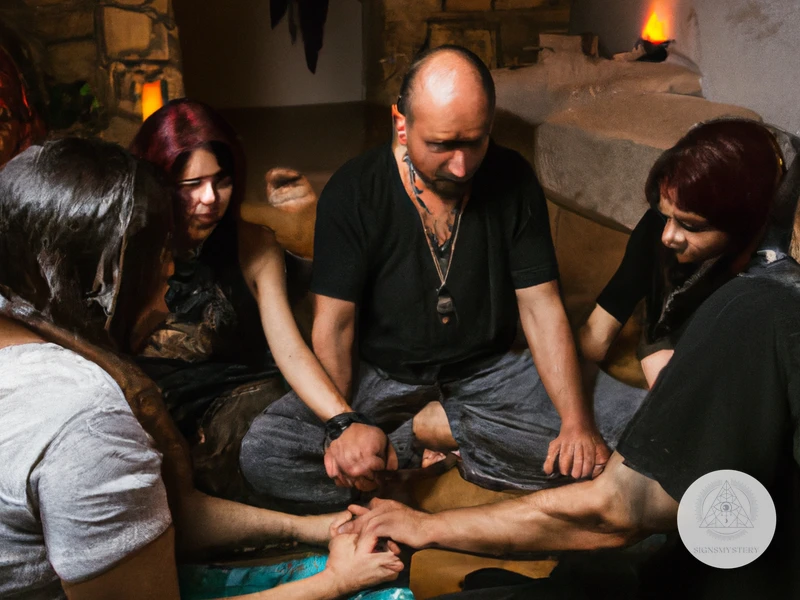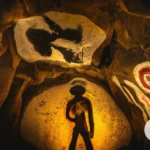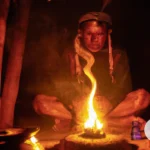Shamanism has been practiced for centuries, evolving over time to adapt to changing cultures and beliefs. Its practices are rooted in the belief that everything in the world is interconnected, and that spiritual energies have the power to heal and transform. One essential component of shamanic healing practices is community. The role of community in shamanism is crucial, providing support, sharing knowledge, and creating a space for spiritual growth. This article explores the importance of community in shamanic healing practices step-by-step, highlighting its role in creating a support system, sharing wisdom, and conducting rituals and ceremonies. By understanding how the community contributes to shamanic healing, we can deepen our understanding of this powerful practice and strengthen our connection to the spiritual world.
What is Shamanism?

Shamanism is an ancient spiritual practice that aims to connect individuals with nature, spirits, and the universe. It is believed that shamans have access to a spiritual realm and can communicate with spirits to bring healing and insight into people’s lives. Shamanic healing practices involve various techniques such as energy work, breathwork, music, plant medicine, and shapeshifting. These practices are often conducted by a shamanic practitioner who acts as a mediator between individuals and the spiritual realm. Shamanism places a strong emphasis on community and the importance of working together in group healing sessions, sharing knowledge and wisdom, and conducting rituals and ceremonies for spiritual growth. Some common rituals include soul retrieval, journeying, and using different methods of shamanic healing such as plant medicine or breathwork. In this way, shamanism helps individuals to connect with their inner selves and to the world around them through the guidance of a community and knowledgeable practitioners.
The Concept of Shamanism
In the concept of shamanism, it is believed that shamans are able to communicate with the spiritual world and perform healing practices. The practice of shamanism has been found in various indigenous cultures around the world, but the core beliefs remain relatively similar.
One of the fundamental beliefs in shamanism is that everything is alive and has a spirit, including animals, plants, rocks and even inanimate objects. Shamans believe that by communicating with these spirits, they are able to gain insight and wisdom in order to facilitate healing for individuals or the community.
Another key element of shamanism is the practice of shamanic journeying, where the shaman enters a trance-like state to access the spiritual world. This can be done through various methods such as drumming, breathwork or the use of plant medicines. During the journey, the shaman may encounter spirit guides or power animals who offer guidance and assistance.
Shamanism also emphasizes the importance of ritual and ceremony in connecting with the spiritual world. Many shamanic practices involve the use of music, dance and chanting to create a sacred space and allow for a deeper connection with the spirits. This can be seen in ceremonies such as Ayahuasca, which involves the use of a powerful plant medicine to induce a trance-like state and connect with the spiritual realm.
Shamanism is a complex and deeply spiritual practice that has been used for centuries to promote healing and wellbeing. Its emphasis on the interconnectedness of all beings and the power of the spiritual world can offer a unique perspective on health and holistic healing.
Shamanic Healing Practices
Shamanism is an ancient practice that involves utilizing various techniques to heal individuals, communities, and the environment. involve a combination of spiritual, emotional, mental, and physical healing. These techniques have been passed down over generations, and each individual healer has their unique approach to shamanic healing.
Some of the most common shamanic healing practices include:
- Plant Medicine: Plant medicine is a fundamental aspect of shamanic healing practices. The shaman utilizes the natural power of plants to heal individuals. It involves using herbs, plants, and other natural substances to create a plant medicine brew that is consumed by the patient.
- Music: Music is an integral component of shamanism. It involves playing various instruments, such as drums, flutes, or rattles, and singing special songs to create a healing environment. The sound of music helps put the patient in a trance-like state, which makes them more receptive to healing.
- Shapeshifting: Shapeshifting involves changing one’s physical appearance, either by shifting into an animal form or taking on the qualities of the animal. In shamanism, animals are considered to have unique and valuable medicine that can be used for healing
- Rituals: Shamanic rituals involve creating a sacred space and establishing a spiritual connection with the universe. These rituals can involve smudging, the use of crystals, and other items to create a healing environment.
- Soul Retrieval: Soul retrieval involves bringing back lost soul parts and restoring wholeness to the individual. This technique is used when the individual experiences trauma or intense emotional pain, causing them to lose a part of their soul.
- Breathwork: Breathwork involves the use of specific breathing techniques to move energy through the body and release emotional and mental blockages. It is a powerful way to work with the subtle body and release issues that may be affecting the individual’s physical body.
- Shamanic Journeying: Shamanic journeying involves entering an altered state of consciousness to connect with the spiritual realm. The shaman journeys to retrieve information, access healing energies, or connect with spiritual guides to provide guidance and support.
- Mental Health: Shamanic healing practices have been proven to be effective in treating various mental health issues, including depression, anxiety, PTSD, and addiction. The shaman works with the individual to identify the root cause of their issues and use shamanic techniques to overcome them.
Shamanic healing practices offer a unique way to approach healing, addressing the individual’s spiritual, emotional, and physical needs. Each technique can be used alone or in combination with other modalities, depending on the individual’s specific needs. By working with a shaman and participating in shamanic practices, individuals can access profound healing and spiritual growth.
The Importance of Community
In shamanism, the community plays a vital role in the healing process. Through creating a support system, individuals seeking healing can find comfort and strength from the people around them. Moreover, sharing knowledge and wisdom within the community facilitates the exchange of ideas and experiences, making it easier for people to learn about different shamanic healing practices and incorporate them into their own healing processes. Communal rituals and ceremonies are key to shamanic healing because they create a space for collective healing and release. These group healing sessions help people to feel connected and supported, facilitating the healing process. Community plays a key role in shamanic healing practices, making it an essential component to the individuals seeking healing.
Creating a Support System
By its very nature, shamanism is a community-centric practice. Shamanic practitioners are not only healers but they also serve as intermediaries between the spiritual realm and the community they serve. One of the key components of shamanic healing practices is the creation of a support system within the community. This support system is essential in ensuring that those who seek shamanic healing receive the guidance and assistance they need to undertake their journey towards healing and self-discovery.
The creation of a support system within the community is important because it helps to build trust and a sense of security among those seeking shamanic healing. By sharing their experiences with others who have undergone similar journeys, people are able to understand that they are not alone in their struggles, which can be a powerful motivator for change. The support system can be created through various means including online communities, group meetings, and workshops.
In addition to building trust and providing a sense of security, the community support system can also provide access to important resources that are necessary for shamanic healing. For instance, experienced practitioners within the community can offer advice and guidance to those who are just starting their journey. Through the community support system, people can access vital resources such as plant medicine, breathwork, shamanic journeying, music, and shamanic rituals that are important components of shamanic healing practices.
Creating a support system within the shamanic healing community also enhances the healing process by introducing a sense of accountability. When people share their healing journey with others, they are more likely to stay committed to their journey, work harder and be accountable for their actions. This accountability helps keep people grounded and focused on their path to healing.
It is important to emphasize that the creation of a support system is an essential component of shamanic healing practices. It provides a sense of security and trust, and access to important resources that are necessary for shamanic healing. This sense of community also fosters a sense of accountability, which helps to keep individuals focused on their healing journey and empowers them to create meaningful change in their lives.
Sharing Knowledge and Wisdom
Sharing knowledge and wisdom is an integral aspect of shamanic healing practices and the role of community in shamanism. Through knowledge sharing and storytelling, individuals can learn about the experiences and techniques of others, gaining insight into their own healing journeys.
Shamans are considered to be keepers of ancient knowledge, passed down through generations, and it is their responsibility to pass on this knowledge to others. In a community, this knowledge exchange serves as a way to expand everyone’s understanding of shamanism and healing practices.
During community gatherings, people share their experiences of shamanic rituals and ceremonies, including dance, song, and meditation. These gatherings also provide an opportunity for people to learn about tools such as plant medicine and breathwork, both of which hold a central place in shamanism.
One of the most essential forms of knowledge sharing in shamanism is through storytelling. Storytelling allows individuals to understand the depths of human experience and the complexities of life. It offers an opportunity for individuals to share their wisdom and inspire others to find their own answers. Stories can also be used to convey ancestral knowledge and serve as a bridge between the present and the past.
When a community comes together to share knowledge, it creates an environment that supports healing and encourages personal growth. By learning from others’ experiences, individuals can expand their understanding of shamanic healing practices and use them to enhance their own healing journey.
As we’ve discussed, various techniques are used in shamanic healing practices. To learn more about them, please visit the following links:
- Plant Medicine Shamanic Healing
- Music and Shamanic Healing
- Shapeshifting Healing Shamanism
- Shamanic Ritual Healing
- Understanding Soul Retrieval Shamanism
- Breathwork Shamanic Healing
- Shamanic Journeying Healing
- Shamanism Mental Health
Rituals and Ceremonies
Rituals and ceremonies are an integral part of shamanic healing practices and are often performed in a group setting. These practices help to establish a sacred space and connect individuals to the spirits and energies of the natural world. Here are some common rituals and ceremonies in shamanism:
| Ritual/Ceremony | Description |
|---|---|
| Vision Quest | A ceremony where individuals spend time alone in nature seeking a vision or messageSubscribe to Our NewsletterSign up to receive the latest news and updates. |
| Fire Ceremony | A ritual involving the lighting and tending of a sacred fire to release negative energy and offer prayers or offerings to the spirits. |
| Sweat Lodge | A small enclosed structure where individuals enter to experience intense heat and humidity. The experience is believed to be purifying and healing. |
| Drum Circle | A gathering where participants play drums, rattles, or other instruments to create a healing and meditative rhythm. |
These rituals and ceremonies often involve the use of specific tools such as drums, rattles, feathers, and crystals to help connect individuals to the spirit world. They may also involve the use of plants such as ayahuasca or peyote to induce altered states of consciousness and facilitate deeper spiritual experiences.
Participating in these rituals and ceremonies within a community setting allows individuals to share in the collective energy and intention of the group. It also provides a sense of community and support, which can be especially important during times of personal healing and growth.
However, it is important to approach these practices with caution and respect for their cultural significance. It is recommended to seek out experienced and knowledgeable practitioners to guide and facilitate these rituals and ceremonies.
Group Healing Sessions
are an essential part of shamanic healing practices. They create a space where individuals can come together and experience healing in a supportive and nurturing environment. These sessions can take place in various settings, including workshops, ceremonies, or retreats.
During group healing sessions, individuals come together as a community to support each other in their healing journey. The group setting provides a safe space for individuals to open up and share their experiences. Sharing experiences with others who have gone through similar struggles can be incredibly healing and transformative.
Group healing sessions can involve various shamanic practices such as drumming, chanting, energy work, and guided meditations. These practices can help create a connection between the participants, promote deep relaxation, and induce a trance-like state. In this state, individuals can access their subconscious minds and align themselves with their inner wisdom and guidance.
Moreover, group healing sessions can also involve the participation of a shaman or healer. They take on the role of a facilitator who works with the group to create a healing space. The shaman may lead the group on a shamanic journey or guide them through energy healing practices that promote spiritual and emotional growth.
Participating in group healing sessions can have many benefits. It can create a sense of belonging, reduce feelings of isolation and loneliness, and provide individuals with emotional and social support. Group sessions can also help individuals create a deeper connection with nature, the universe, and their inner selves, leading to profound spiritual growth.
In conclusion, group healing sessions play a vital role in shamanic healing practices. They offer a safe and supportive environment where individuals can come together and share their experiences, receive emotional and spiritual support, and create a deeper connection with their inner selves and the world around them.
Community as a Source of Spiritual Growth
As humans, we are social beings. We function best when we are surrounded by others, and this is especially true in the spiritual realm. Community plays a significant role in spiritual growth as it provides us with the necessary support, encouragement, and resources needed to deepen our spiritual practice.
Being part of a spiritual community gives us an opportunity to connect with like-minded individuals who share similar beliefs and values, and this connection provides a sense of belonging and support. Through this connection, we are able to learn from others and share our own experiences in a safe and supportive environment.
Spiritual communities often organize various activities and events that promote spiritual growth, such as workshops, retreats, and meditation groups. These events can not only deepen our spiritual practice but also provide opportunities to learn new skills and practices.
One of the most significant benefits of being part of a spiritual community is the opportunity to participate in group rituals and ceremonies. These rituals and ceremonies serve as powerful tools for healing, transformation, and growth. When we come together in a community setting to participate in these practices, we create a powerful collective energy that can facilitate profound healing and transformation.
Aside from the benefits that community offers us, our participation in a spiritual community also contributes to the growth and healing of the community as a whole. When we engage in spiritual practice, we awaken our inner selves, and this awakening can radiate out to those around us, inspiring positive change.
It is clear that community plays a crucial role in our spiritual growth. Through community, we find support, resources, and connection that help us deepen our practice and connect with our inner selves. As we participate in community activities and rituals, we also contribute to the growth and healing of the community as a whole, making it a mutually beneficial relationship.
Conclusion
Conclusion: In conclusion, the role of community in shamanic healing practices is of utmost importance. It not only provides a support system for individuals going through the healing process but also helps in creating a conducive environment for spiritual growth. Shamanism, as a practice, is all about connecting with the larger universe and the community plays a vital role in facilitating these connections.
Through community rituals, ceremonies, and group healing sessions, individuals can share knowledge and wisdom, explore new perspectives, and gain insights that may not have been possible on their own. This not only benefits the individuals but also strengthens the collective energy of the community.
The importance of community cannot be overstated when it comes to shamanic healing practices. It is the foundation upon which the practice is built and without it, the healing process may not be as effective. The community provides a safe space for individuals to open up, share their experiences, and receive support and guidance.
In summary, if you are looking to explore shamanic healing practices, it is important to find a supportive community that resonates with your beliefs and values. This will not only enhance your healing journey but also provide a space for spiritual growth and connection. Remember, shamanism is not an individual journey, but a collective one.
Frequently Asked Questions
What is the definition of shamanism?
Shamanism is a practice that involves a practitioner reaching altered states of consciousness in order to perceive and interact with a spirit world and channel these transcendental energies into the physical world for healing purposes.
What are some shamanic healing practices?
Shamanic healing practices include soul retrieval, power animal retrieval, extraction, divination, and psychopomp work, among others.
What is soul retrieval?
Soul retrieval is a shamanic healing practice that involves the practitioner helping someone retrieve a lost aspect of their soul due to trauma or pain. The practitioner works to integrate this lost aspect into the client’s present self.
How does community play a role in shamanic healing practices?
Community plays a crucial role in shamanic healing practices by providing a supportive network, sharing knowledge and wisdom, participating in rituals and ceremonies, and facilitating group healing sessions.
What are the benefits of participating in group healing sessions?
Participating in group healing sessions can provide a sense of community, support, and shared intention, as well as a space for personal healing and growth.
What is the importance of creating a support system in shamanic healing practices?
Creating a support system can help clients feel held and safe while going through the often transformative and challenging process of healing. It can also provide a sense of accountability and motivation.
What are some examples of shamanic rituals and ceremonies?
Examples of shamanic rituals and ceremonies include sweat lodges, vision quests, medicine wheel ceremonies, and plant medicine ceremonies.
What is psychopomp work?
Psychopomp work is a shamanic healing practice that involves helping spirits cross over from the physical realm into the spirit world, or vice versa.
What is power animal retrieval?
Power animal retrieval is a shamanic healing practice that involves the practitioner helping a client connect with their power animal, an animal spirit that provides guidance, protection, and support.
How can community be a source of spiritual growth?
Community can provide opportunities for learning, growth, and access to teachings and practices that may not be available on an individual basis. It can also provide a sense of connectedness and belonging, which can be integral to personal spiritual growth.










